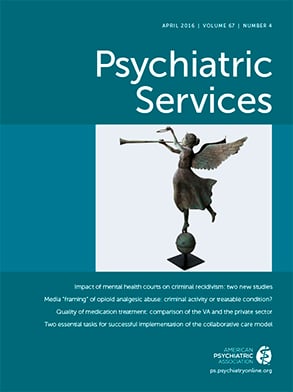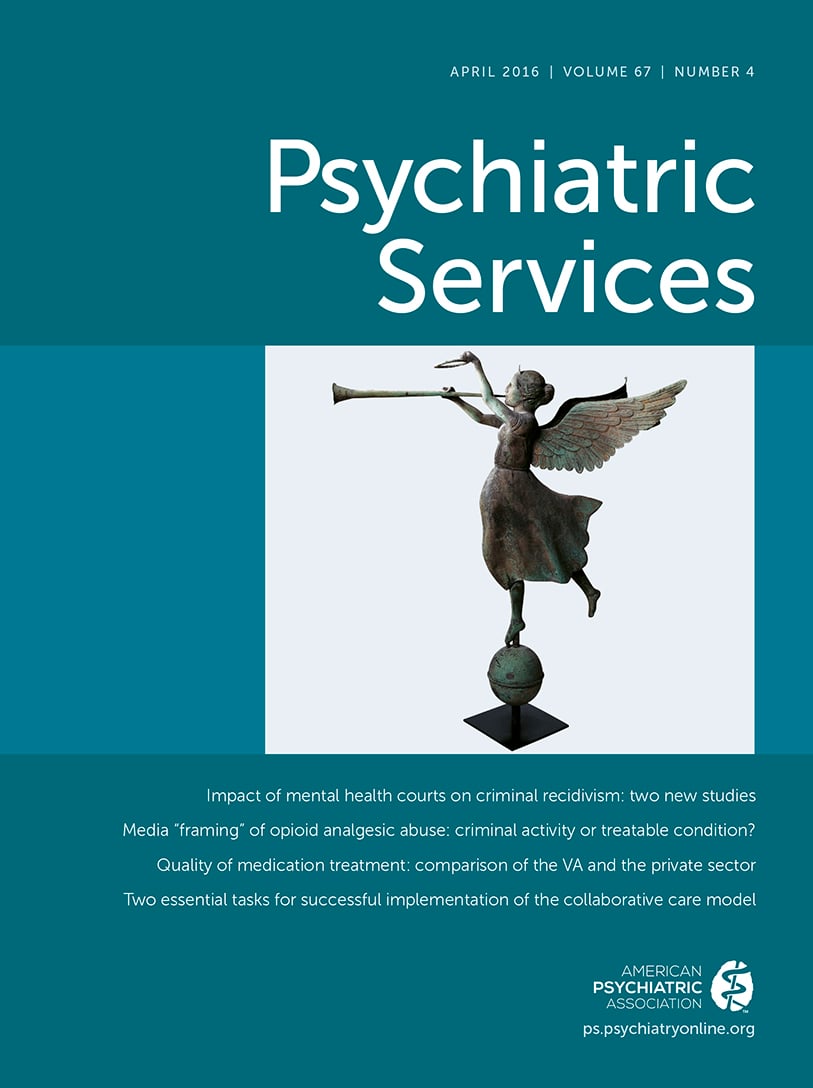Detoxification is an important component of the system of care for patients with addictions. It provides medically supervised withdrawal from a substance of dependence so that the severity of withdrawal symptoms and serious medical complications, which may be fatal, are reduced. Detoxification is completed safely and effectively in outpatient and inpatient settings. This study examined variability across Veterans Health Administration (VHA) facilities in use of detoxification services, completion of follow-up care, and transition of patients to specialty treatment and determinants of variability in these service utilization patterns. Understanding variation in detoxification services across health care settings is important because higher rates of initiation, follow-up care, and transition to specialty care are associated with better patient outcomes and less use of expensive emergency services (
1).
Initiation and utilization of detoxification are greater when patients have experienced a recent drug overdose and have a history of prior treatment and when the facility has shorter wait times to care (
2). Detoxification completion and follow-up are associated with demographic (older, employed, educated, and residentially stable) and clinical (dependent on alcohol rather than drugs; no previous detoxifications) characteristics of the patient. Facilitators of transitioning from detoxification to specialty treatment include patient factors (homelessness and less chronic and less severe substance use) and facility factors (smaller treatment programs) (
3). Policy responses to homelessness have placed special emphasis on addiction treatment to slow the ‘‘revolving door’’ of relapse after detoxification (
4). The VHA is putting considerable resources into ending homelessness, in that its programs provide individualized, comprehensive care to veterans with unstable housing or who are at risk of becoming homeless (
www.va.gov/homeless).
This study examined patient-level and facility-level factors associated with detoxification initiation among patients with alcohol or opiate dependence, completion rates of follow-up within seven days among patients receiving detoxification, and rates of transition to addiction treatment. Understanding determinants of patient-level and cross-facility variability can inform efforts to improve rates of detoxification initiation, follow-up care, and treatment.
Methods
The sample included patients from the VHA National Patient Care Database (with one or more general medical, mental health, or addiction encounters at a VHA facility in fiscal year 2013) who were diagnosed as having alcohol dependence, opiate dependence, or both and who were not on opiate agonist therapy (N=266,908). These data were linked to facility-level (N=141 facilities) data from the Drug and Alcohol Program Survey (DAPS;
5) of every VHA addiction treatment program. We calculated the proportion, overall and at each VHA facility, of VHA patients with dependence who received outpatient or inpatient detoxification services (
ICD-9-CM procedure codes and pharmacy data, N=21,331), of detoxification patients who received a one-week follow-up visit (N=9,202), and of detoxification patients who received specialty treatment within 60 days of ending detoxification (N=10,648).
To examine predictors of service utilization, we conducted mixed-effects logistic regressions with receipt of detoxification, follow-up, or specialty treatment as the dichotomous (0=no; 1=yes) dependent variable and a random effect for facility. Predictors consisted of patients’ demographic characteristics and clinical status and facility characteristics as reported in the DAPS (
Table 1). We examined bivariate associations between predictors and dependent variables and then selected candidate predictors significant at p<.20 for final regression models (
6).
Results
The overall percentage of patients with alcohol or opiate dependence who received detoxification services was 8.0% (95% confidence interval [CI]=7.8%−8.1%) and varied by facility from .1% to 20.4%. The overall percentage of patients completing detoxification who attended the one-week follow-up appointment was 43.1% (CI=42.5%−43.8%, range 11.1%−76.4%). The proportion who entered addiction treatment was 49.9% (CI=49.3%−50.6%, range 13.0%−77.2%). Addiction treatment was obtained only in specialty outpatient (74.6%, N=7,944), in outpatient and residential (23.2%, N=2,470), and in residential (2.2%, N=234) treatment programs. Of patients who completed a one-week follow-up appointment, 69.2% (N=6,368) attended treatment; of patients who attended treatment, 80.1% (N=8,529) had received follow-up.
Patient characteristics associated with higher odds of detoxification across VHA facilities were being male, younger, white (versus Hispanic, black, or another race or ethnicity), and homeless; having more rather than fewer general medical conditions; receipt of any previous addiction treatment and more rather than less previous addiction treatment; and having a diagnosis of alcohol or opiate abuse or dependence documented in the medical record in the preindex period. In bivariate analyses, the only facility characteristic associated with detoxification was having fewer vacant addiction therapist or counselor positions (
Table 1). When all predictors with an association (p<.20) with detoxification were entered into the final regression model, significant patient predictors were being male, younger, non-Hispanic white (rather than Hispanic, non-Hispanic black, Asian, or another race-ethnicity), and homeless and having medically documented alcohol and opiate abuse and dependence in the preindex period. The significant facility predictor was having fewer vacant addiction therapist or counselor positions. [Results of the final regression model for receipt of detoxification are provided in the
online supplement to this report.]
Examination of detoxification follow-up appointments completed showed significant patient demographic characteristics, including being female, younger, black (compared with white), and homeless; significant clinical characteristics included having fewer comorbid conditions, a history of previous addiction visits, a greater number of such visits, and alcohol use disorder or opiate use disorder diagnoses documented in the medical record. Again, facility characteristics associated with completion of a detoxification follow-up appointment were related to staffing: more social workers to provide addiction treatment and more facility staff members overall (
Table 1). When all predictors associated (p<.20) with follow-up completion were entered into the final regression model, significant patient-level predictors were younger age, homelessness, having fewer comorbid conditions, a history of previous addiction visits, and an alcohol use disorder diagnosis in the medical record. On the facility level, fewer vacant addiction therapist-counselor positions was significant. [A table in the
online supplement to this report provides further detail.]
Successful transitions from detoxification to addiction treatment were significantly associated with patients who were female, younger, black, and homeless and who had fewer comorbid conditions, previous addiction treatment, more rather than fewer previous addiction treatment visits, and an alcohol diagnosis and opiate diagnosis documented in the medical record. Having more social workers to staff addiction treatment and having more facility staff members overall were related to higher transition rates (
Table 1). When all predictors with an association (p<.20) with transition to addiction treatment were entered into the final regression model, significant patient-level predictors were being younger, black rather than white, and homeless and having fewer comorbid conditions, a history of previous addiction treatment, and a diagnosis of alcohol use disorder but not opiate use disorder in the medical record.
Discussion
Although only 8% of VHA patients with alcohol or opiate dependence (or both) received detoxification services, the proportion of patients who received detoxification and the required follow-up appointment was higher, at 43%, and the proportion of patients who entered detoxification and then entered addiction treatment was even higher, at 50%. However, rates for each of these services varied substantially across facilities. These findings may be useful for targeting quality improvement efforts in facilities where services reached fewer patients. In addition, facilities performing better should be examined more closely to delineate practices by which they provide more enhanced detoxification initiation, follow-up, and continuity of care to specialty treatment.
Rates of post-detoxification transition to addiction treatment have been found to vary widely, depending on the sample (
7). Evidence has shown that some interventions assist health facilities in enabling patients to progress from detoxification to treatment and thereby improve outcomes. These interventions include familiarizing patients during the detoxification episode with the addiction treatment program that they will subsequently enter (for example, detoxification staff escort patients to programs where, together, they meet with a counselor) (
8); providing ongoing, face-to-face intensive case management (
9); and providing patient incentives to enter treatment (
10). However, these efficacious interventions may not be feasible to implement routinely in VHA or other health care systems because of the substantial staff resources they require; because treatment program choice, out of a menu of options, differs among patients, and may be uncertain at the time of discharge, or geographically distant from the detoxification setting; and because there may be a wait time between detoxification completion and treatment availability (
11). In addition, such resource-intensive approaches may not be necessary for detoxification patients to engage with treatment and achieve positive outcomes. For example, telehealth interventions offer innovative, high-value approaches to facilitate transitions from detoxification to treatment (
12). Furthermore, the extent to which detoxification settings develop relationships within a network of service delivery agencies may increase the number of treatment settings to which they refer patients, which may in turn increase the number of patients receiving treatment (
13). When agencies are given information in a timely fashion about patients who may be at risk of failing to transition from detoxification to treatment, they can make more intensive efforts to schedule treatment for those patients (
7).
Of patients who had alcohol or opiate dependence or the combination, those who were male, younger, white, and homeless were more likely to obtain detoxification services. For example, the percentages of homeless and housed veterans obtaining detoxification services were 15.7% and 5.5%, respectively. Similarly, of patients who obtained detoxification services, those who were younger and homeless were more likely than others to obtain follow-up care and transition to addiction treatment; however, detoxification patients who were black were more likely to enter addiction treatment. That homeless patients were more likely to receive treatment may be due in part to their use of VA supported housing options and residential services. Specifically, the VA defines homelessness as a report of yes to one or more of four criteria: being homeless, having had a recent visit in a clinic indicative of homelessness services, receiving domiciliary services, and housing instability.
Clinically, patients with more comorbid conditions and without previous addiction treatment regardless of documented alcohol or opiate use disorders were more likely to receive detoxification services. However, patients with fewer comorbidities and with previous specialty care and documented alcohol abuse or dependence in the medical record were more likely to obtain follow-up and specialty treatment after detoxification. Our findings agree with reports that one of the most important predictive factors for failure to transition from detoxification to addiction treatment is greater severity of general medical problems (
3). Examination of facility factors showed that having fewer addiction therapist vacancies was associated with higher rates of detoxification and follow-up services. Most likely, vacancies entail higher staff demands, underscoring the need to reduce turnover. However, the finding concerning addiction therapist vacancies needs replication, given the lack of significant associations between other staffing indicators and outcomes.
Because this study was observational, conclusions about cause-and-effect relationships cannot be made concerning the observed significant associations. In addition, generalizability to private-sector settings may not be appropriate. However, most addiction patients are treated in the public sector (
14). By using administrative data, we may not have had patients’ complete treatment records; that is, if a patient sought detoxification or subsequent services outside the VHA, our analyses would not have captured them.
In spite of these limitations, our results show consistent findings that relatively older patients with stable housing but more severe general medical problems who received detoxification were less likely than others to receive follow-up procedures or subsequent specialty care. Detoxification may be medically riskier for older persons without appropriate added cautions, but addiction treatment is often effective for them (
15). Improving patterns of service utilization related to detoxification—increased initiation of such services, adherence to follow-up, and transition to specialty care—has a number of potential benefits that are critically important to patients’ long-term health. These include increasing the likelihood of abstinence and of recovery and decreasing the likelihood of accumulated detoxification episodes and a chronic course of substance dependence, both of which are associated with poor mental health and general medical outcomes and the use of costly health services.

